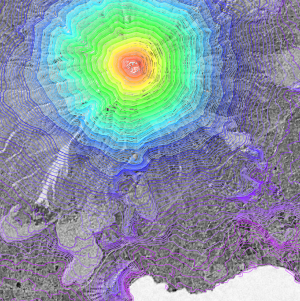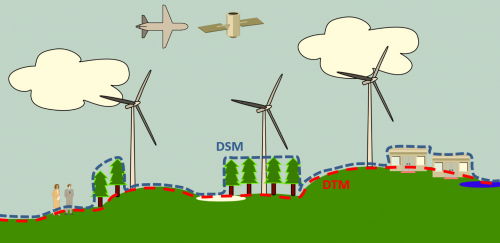Difference between revisions of "Category:Digital Elevation Models"
m (→Introduction) |
|||
| Line 2: | Line 2: | ||
[[File:ExampleSRTM.png|left|thumb|300px|Satellite Image with DEM Overlay. The image shows a part of the Ometepe Island in Lake Nicaragua with SRTM height contour data.]] | [[File:ExampleSRTM.png|left|thumb|300px|Satellite Image with DEM Overlay. The image shows a part of the Ometepe Island in Lake Nicaragua with SRTM height contour data.]] | ||
==Introduction== | ==Introduction== | ||
| − | The digital height models in WindPRO are based on many different national and global sources. The best globally-available DHM source remains the Shuttle Radar Topography Mission (SRTM) data - in its 1-arc-second resolution, but more countries are releasing national data under open-data licenses. Typically these have a much better resolution than SRTM - and it is often recommended to use local sources for DEM modelling - if such higher-quality are available for a particular site. EMD and the windPRO team are continiously working to add better and highter quality DEM's into the data-services of windPRO - so please let us know if you know of data-sources that you would like to see in windPRO. | + | The digital height models in WindPRO are based on many different national and global sources. The best globally-available DHM source remains the Shuttle Radar Topography Mission (SRTM) data - in its 1-arc-second resolution, but more countries are releasing national data under open-data licenses. Typically these have a much better resolution than SRTM - and it is often recommended to use local sources for DEM modelling - if such higher-quality are available for a particular site. |
| + | |||
| + | ==Let us know!== | ||
| + | EMD and the windPRO team are continiously working to add better and highter quality DEM's into the data-services of windPRO - so please let us know if you know of data-sources that you would like to see in windPRO. Just drop us an email at support@emd.dk. | ||
=== Considerations === | === Considerations === | ||
Revision as of 12:23, 23 September 2019
Introduction
The digital height models in WindPRO are based on many different national and global sources. The best globally-available DHM source remains the Shuttle Radar Topography Mission (SRTM) data - in its 1-arc-second resolution, but more countries are releasing national data under open-data licenses. Typically these have a much better resolution than SRTM - and it is often recommended to use local sources for DEM modelling - if such higher-quality are available for a particular site.
Let us know!
EMD and the windPRO team are continiously working to add better and highter quality DEM's into the data-services of windPRO - so please let us know if you know of data-sources that you would like to see in windPRO. Just drop us an email at support@emd.dk.
Considerations
When using the remote sensing digital height models, you must manually consider the accuracy of the dataset used. This is especially important in the vicinity of the wind farm and other associated objects such as meteorological masts, noise and shadow receptors and photomontage viewpoints. Typically – when applying remote sensing DHMs - the height contour lines must be validated against a local topographical map. In addition, many of the wiki-pages in here provide links to further documentation and an overview of vertical and horizontal acurracy.
What type of elevation model? DEM, DSM and DTM?
For wind energy applications, it is important to undserstand if the model is a DEM, DSM or a DTM. In windPRO we use the following abbriations when dealing with DEM's.
1. DEM (Digital Elevation Model) - Is often used as a generic term for both DSM's and DTM's.
2. DSM (Digital Surface Model) - Is a surface representation with objects.
3. DTM (Digital Terrain Model) - Is the bare earth representation without objects.
Pages in category "Digital Elevation Models"
The following 54 pages are in this category, out of 54 total.
G
- German Bavaria Elevation Models
- German Berlin Elevation Model
- German Brandenburg Elevation Model
- German DGM datasets
- German Hamburg Elevation Model
- German Hessen Elevation Models
- German NRW Elevation Model
- German Saxony Elevation Models
- German Saxony-Anhalt Elevation Models
- German Thuringia Elevation Models
- Global AW3D30

